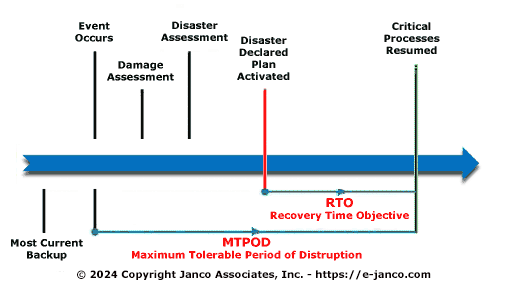Disasters Happen -- Business Continuity Disaster Recovery
How do you balance the business continuity disaster recovery risk and investment equation? Is the potential risk greater than the investment? The facts are:
- 43% of companies experiencing disasters never reopen, and 29% close within two years.
- 93% of businesses that lost their data center for10 days went bankrupt within one year.
- 40% of all companies that experience a major disaster will go out of business if they cannot gain access to their data within 24 hours.
Order DRP BCP Template Sample DRP BCP Template History
Downtime and loss of data, even if temporary, can have long-lasting effects for business and can contribute to the demise of the otherwise well-managed business:
- Loss of revenue from your customers' inability to do business with you
- Diminished market credibility and customer trust, resulting in churn
- Penalties for violated SLAs with partners, suppliers, distributors, and franchisees
- Costs of recovering and repairing the lost data
- Legal costs of meeting internal and external compliance requirements
How do you balance the business continuity risk and investment equation? Is the potential risk greater than the investment? Some facts:
- 43% of companies experiencing disasters never reopen, and 29% close within two years.
- 93% of businesses that lost their data center for 10 days went bankrupt within one year.
- 40% of all companies that experience a major disaster will go out of business if they cannot gain access to their data within 24 hours.
CIOs and Business Continuity Managers should plan for all situations in which normal operations are disrupted and have practices and technologies in place that enable them to deal with potential disruption from hostile, external actions as well as internal system failures.
Business Continuity Defined
Business continuity planning is a process that help organizations prepare for disruptive events—whether those event might include a hurricane or simply a power outage caused by a backhoe in the parking lot.
The CIO's involvement in this process can range from overseeing the plan, to providing input and support, to putting the plan into action during an emergency.
Business continuity planning is now accepted as basics requirement for every business and organization. It is widely accepted that a detailed business continuity plan should not only exist, but should be up to date. It should reflect the actual on-going needs of the business activity or function. But how do you ensure that this is actually the case?
If you have a plan, do you know that it will all work? Do you ever audit it, and if so, how? Equally importantly, do you know what your service/resource dependencies are and what their time criticalities are? What of your everyday contingency practices - do they measure up to close scrutiny?
Janco's Business Continuity Template is the Industry Standard
Essential Tool for Organizational Resilience and Survival. It is the ideal for Business Continuity practitioners seeking a…
- State of the art presentation of the global body of knowledge for DR/BC, including current international standards and best practices.
- Flexible, modular design that allows you to create a customized business continuity plan: Provides real world text with clear definition of fundamental principles and practices; Detail on Information Technology and Emergency Management for those focusing in these areas; a 20 page Business and IT Impact Questionnaire; and a detail work plan, business impact, and business continuity management, which is task oriented. Both the Business Continuity Planning Organization and the IT Productivity Center (ITPC) have endorsed the book.
- Quick reference for your business continuity team offering a readable blend of academic principles and practical applications—an effective tool for grounding interdepartmental teams developing and maintaining BCP plans.
Business Continuity Management
Options you have to order the BCP Template include





